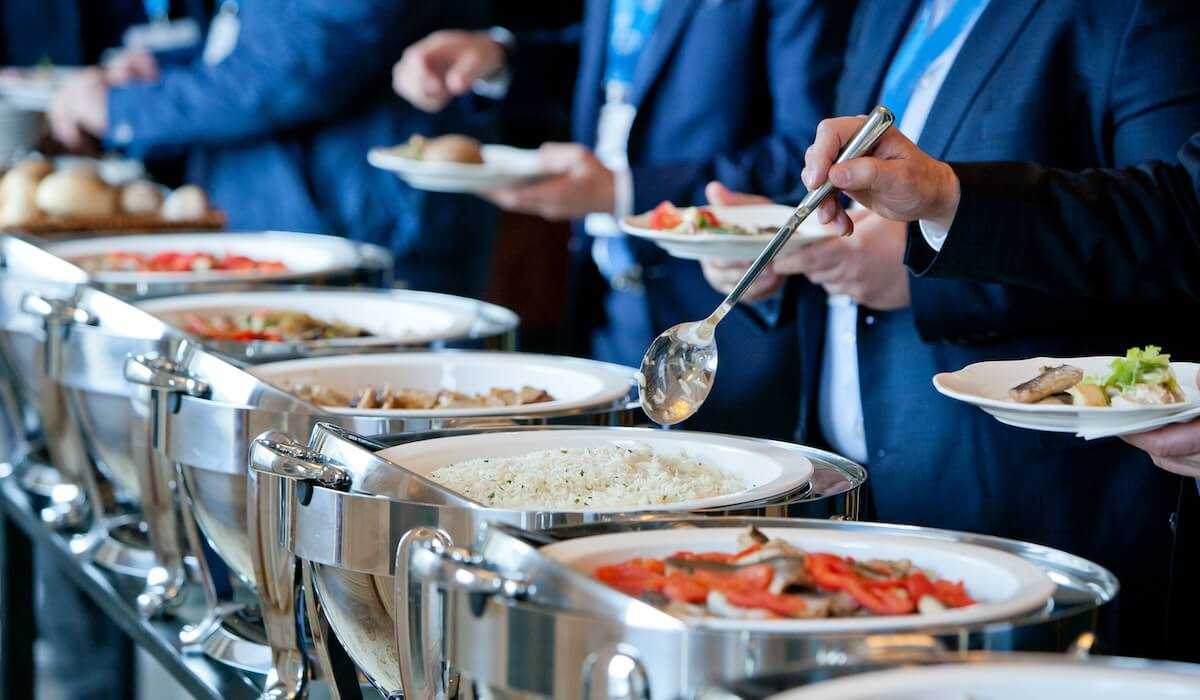Providing employees with meals has a range of benefits for businesses—from boosting job satisfaction to creating opportunities for team bonding and improving retention rates. With an organized, thoughtful approach to corporate dining, you can maximize these benefits for your company.
Planning corporate dining
Corporate meals come in all shapes and sizes. No matter what type of event you’re planning, there are a few key factors to consider.
Practicalities
Before you can start organizing a meal at work, it’s important to square away the practical requirements:
- Occasion. Why are you hosting the meal?
- Group size. The number of people you’re serving affects the food type, location, and ordering method.
- Budget. Figure out how much your company can spend on the meal. The budget should be large enough to provide high-quality food but not so big that it creates a financial strain.
Types of food and food service
Determine the type of food you want to serve and how you want to serve it. For an office happy hour, you might hire servers to circulate with appetizers. A workday meal could warrant a family-style Mexican feast or sandwiches.
Options to choose from include:
- Passed appetizers
- Buffet
- Food stations
- Table service
- Individually packaged meals
These elements can help you narrow down the best food types and service styles:
- Event type. To a large extent, the occasion sets the tone for a corporate dining event. A formal gathering, such as an annual gala or a board-meeting dinner, typically requires more formal food and service options. A celebratory team lunch could involve food delivery in the break room.
- Operational limitations. If the meal will take place during a workday, consider how your operations impact the options. When you’re feeding shift workers in a hospital or retail store, for example, it’s probably not possible to eat as a group. Instead, you might set up a hot buffet workers can visit during their scheduled lunch breaks.
- Workplace schedule. Consider what attendees are doing before and after the meal. Are they racing to and from other commitments, or will they have time to linger?
- Budget. Some options, including plated meals and full-service catering, require a bigger budget.
Menu selection
The menu is often the most complicated aspect of corporate meal planning—every guest has different preferences and dietary limitations, and it’s your responsibility to ensure everyone has something tasty to eat.
There are multiple ways to approach the process:
- Request preferences in advance. Send out an online survey to ask about attendees’ preferences and dietary restrictions. This option requires more legwork, but ensures you have accurate information.
- Offer a range of options. Plan a menu that includes an entrée and sides to accommodate most common allergies and dietary needs: vegan/vegetarian, gluten-free, nut-free, and dairy-free. You might also need to offer kosher and halal options.
- Allow individual meal selection. Enable guests to choose their own meals. If the event is catered, you might allow everyone to pick from a list of options. Alternatively, services such as Grubhub Corporate Accounts make it easy for employees to select their own meals and add them to a group order.
Ordering options
Determine who’ll prepare the food and how it will get to your location. There are three common options:
- DIY meals. This option works well for office breakfasts. Simply pick up supplies or order them for delivery from a grocery store, and set them out in the break room.
- Delivery from local restaurants. With services such as Grubhub, it’s easy to order individual and family-style meals from the establishment of your choice.
- Catering. Catered meals are ideal for larger events. You can consider a full-service option that includes setup, teardown, cleaning, servers, and equipment.
Logistics
Organize the final logistics for the meal. Will you need to hire additional staff, or can employees manage it on their own?
Depending on the size and scope of the event, you might need to organize:
- Dining tables and chairs
- Table linens
- Dishes, glassware, and utensils
- Serving dishes
- Warming dishes
- Special electricity supplies
- Serving stations or buffet tables
- Space for dirty dishes
- Food storage and prep areas
- Post-meal laundry
- Trash removal
Anticipating and addressing these requirements in advance helps ensure your meal goes off without a hitch. For an even more streamlined corporate ordering process, turn to Grubhub Corporate Accounts. Whether you’re planning a casual meal with the sales staff or a formal dinner with the leadership team, you can use Grubhub to choose a restaurant or caterer, plan a menu, and schedule a time for delivery. With simple invoicing and effortless budget rules, it’s easy to customize orders for any occasion.
Ready to learn more? Get started with Grubhub Corporate Accounts today.





